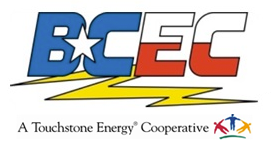ABOUT BAILEY COUNTY ELECTRIC COOPERATIVE ASSOCIATION
Bailey County Electric Cooperative (BCEC) was incorporated in 1938. Our headquarters are in Muleshoe, Texas. We have a district office located in Morton, Texas. BCEC serves portions of the following counties: Bailey, Castro, Cochran, Lamb, and Parmer. The Cooperative has 42 full-time employees who serve approximately 1,492 members. David Marricle has served as President & CEO since 2002.
BCEC has a seven-member Board of Directors with each Director representing one of our seven districts. We have 2,930 miles of energized line serving 8,976 meters and 1,492 members. Our membership consists of irrigators, dairies, gins, oil and gas and residential. We are proud to be active in our communities to make them a better place to live. We are active on the Muleshoe Economic Development Council, Muleshoe Chamber of Commerce, volunteer for the Muleshoe Meals on Wheels and for the Muleshoe SnackPak4Kids program. We offer safety and arcing demonstrations to schools, businesses and other organizations teaching electrical safety. We are proud of our communities we live and work in serving our friends and neighbors.
Enjoy a fast-paced hand-drawn history of America's electric cooperatives.
As late as the mid-1930s, nine out of 10 rural homes were without electric service. The farmer milked his cows by hand in the dim light of a kerosene lantern. His wife was a slave to the wood range and washboard.
The unavailability of electricity in rural areas kept their economies entirely and exclusively dependent on agriculture. Factories and businesses, of course, preferred to locate in cities where electric power was easily acquired. For many years, power companies ignored the rural areas of the nation.
The first official action of the federal government pointing the way to the present rural electrification program came with the passage of the Tennessee Valley Authority (TVA) Act in May 1933. This act authorized the TVA Board to construct transmission lines to serve “farms and small villages that are not otherwise supplied with electricity at reasonable rates.”
The idea of providing federal assistance to accomplish rural electrification gained ground rapidly when President Roosevelt took office in 1933. On May 11, 1935, Roosevelt signed Executive Order No. 7037 establishing the Rural Electrification Administration (REA). It was not until a year later that the Rural Electrification Act was passed and the lending program that became the REA got underway.
Within months, it became evident to REA officials that established investor-owned utilities were not interested in using federal loan funds to serve sparely populated rural areas. But loan applications from farmer-based cooperatives poured in, and REA soon realized electric cooperatives would be the entities to make rural electrification a reality.
In 1937, the REA drafted the Electric Cooperative Corporation Act, a model law that states could adopt to enable the formation and operation of not-for-profit, consumer-owned electric cooperatives.
Within four years following the close of the World War II, the number of rural electric systems in operation doubled, the number of consumers connected more than tripled and the miles of energized line grew more than five-fold. By 1953, more than 90 percent of U.S. farms had electricity.
Today, about 99 percent of the nation’s farms have electric service. Most rural electrification is the product of locally owned rural electric cooperatives that got their start by borrowing funds from REA to build lines and provide service on a not-for-profit basis. REA is now the Rural Utilities Service, or RUS, and is part of the U.S. Department of Agriculture.
Cooperatives bring electricity to rural and suburban Texas, turning on the lights and improving quality of life By the 1930s, most urban areas in the United States and Texas had already been living with the conveniences of electricity for nearly 50 years.
A nighttime view over Texas during that era would have shown large clusters of light glowing around Dallas/Fort Worth, Houston, San Antonio, El Paso and Austin. Aside from a few scattered pockets, the rest of the state would have been totally dark.
It was simply not profitable for the existing large, private power companies to serve rural areas. Farm and ranch wives cooked on wood stoves; children did their homework by the dim light of coal-oil lamps; water was pumped by hand, just as it had been for centuries. Radio communication with the outside world was all but unknown.
Finally, in 1935, with the establishment of the Rural Electrification Administration, farmers and ranchers could borrow federal money and take it upon themselves to form local, consumer-owned electric cooperatives. At last, light shone on rural America. The impact was even greater than anyone had imagined. By 1940, 567 cooperatives across the nation were providing electricity to 1.5 million consumers in 46 states. Today, nearly 900 electric co-ops serve 40 million people in 47 states.
In 1935, Bartlett Electric Cooperative in Central Texas was first in the nation to turn on the lights for its members. Today, Bartlett EC is one of the 75 electric cooperatives—64 distribution co-ops and 11 generation and transmission co-ops—that provide safe, reliable electric service at a reasonable cost to nearly 3 million member-consumers in Texas. Texas co-ops own more than 320,000 miles of line serving more than 2.1 million meters in 241 of the state's 254 counties.
Electric cooperatives are democratic, tax-paying, not-for-profit businesses governed by member-elected boards of directors. As member-owned utilities, the distribution systems are self-regulating. In addition to providing electricity and other products and services to their member-consumers, electric co-ops adhere to a proud tradition of community service. Co-op members and employees participate in economic development efforts and are involved in charitable undertakings and numerous other volunteer activities that contribute to quality of life in the communities they serve.
All electric cooperatives adhere to the Seven Cooperative Principles that inform their purpose.
